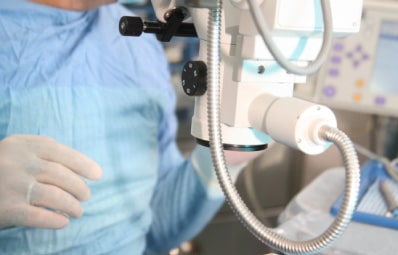
Barnet Dulaney Perkins has adopted topography-guided LASIK. It allows treatment of severe refractive errors that weren’t treatable with previous LASIK technology. The decision to have laser vision correction should be made based on technology but also considering the experience of the LASIK surgeon.
Successful LASIK outcomes are equally a result of selecting the right technology and working with the right eye doctor. You can’t compromise one over the other.
Below, you will learn how to find the right LASIK surgeon and learn more about the latest laser eye surgery technology available to help you accomplish your goal of better eyesight.
The Skill Factor: Finding the Right LASIK Surgeon
LASIK is performed by an ophthalmologist, not by an optometrist nor a general physician.
To find out if your prospective LASIK doctor is a practicing ophthalmologist, you can check with the American Academy of Ophthalmology. To further help you evaluate a LASIK surgeon’s skills, pay particular attention to the following:
Board Certification and Membership with Professional Associations:First, find out if the surgeon is certified by the American Board of Ophthalmology. This organization requires surgeons to undergo specific training and continuing education in their specialty to become a member.
In addition, check for certification by state licensing boards and active memberships with professional associations. Note the certificates you see on the wall and look them up online or ask about them.
Patient Satisfaction Rates:Beware of LASIK providers who advertise 100 percent success rate without sufficient data to back the claim. Visit the patient testimonials page on the doctor’s website, visit google reviews or ask past patients about their experience in working with the surgeon and the rest of the team.
Professionalism:There’s no use being the most skilled LASIK surgeon in the world when the doctor’s practice lacks professionalism and genuine concern for your safety.
Number of LASIK Procedures Performed:If you’ve been reading LASIK guides online, you’ve probably learned that it’s important to find an experienced surgeon.
At Barnet Dulaney Perkins Eye Center, we recommend finding not just experienced ophthalmologists but experienced LASIK surgeons.
What to Ask Your LASIK Surgeon to Gauge Skills
Questions about what’s going to happen during your LASIK procedure or anything else about the surgery are good – especially if they make you more comfortable. Here are a few questions to ask if you’re “comparison shopping.”
- How many LASIK procedures have you performed?
- What type of technology does your practice use for patients requiring LASIK?
- Is my refractive error treatable with LASIK? If not, what procedure do you recommend?
- What results should I expect? How about best and worst case scenarios?
- If my LASIK results won’t accomplish desired outcomes, what type of retreatment is required?
- What type of adjustments at work or home should I do after LASIK?
- What are possible side effects? How do I avoid or lessen them post-LASIK?
The Technology Factor: LASIK Now and Then
Since Dr. Stephen Trokel performed the first laser surgery on a patient in 1987 using an excimer laser, LASIK has come a long way. This laser was previously used to cut computer chips. Dr. Trokel also introduced Photorefractive Keratectomy (PRK), a predecessor of today’s LASIK.
Almost a decade later, the FDA approved LASIK that combined an excimer laser and previously proven flap technology to reshape the cornea. In 2003, Wavefront LASIK was approved for commercial use. Wavefront technology allows doctors to customize surgery to a patient’s unique vision prescription.
In 2016, laser vision surgery topography-guided LASIK now follows mapping of your cornea via computer to navigate its topography down to every bend and ridge. This newest LASIK technology, topography-guided LASIK, allows our LASIK specialists in Arizona to take more accurate measurements and find a solution specific to your eyes’ unique profile. As a result, we are able to provide LASIK to some individuals who would not have been considered for LASIK surgery in the past.
Best LASIK Outcomes = Experience and Highest Level of Technology
For LASIK results to be precise and safe, it’s important to go with the most recent and highest level of LASIK technology. And it’s equally important to put that laser in the hands of a skilled, knowledgeable LASIK surgeon.
If you have more questions or want to schedule a consultation with the most skilled LASIK surgeons in Arizona today call us, 1-866-742-6581. We have 15 eye center locations throughout the Phoenix Valley, Tucson, and northern Arizona.

